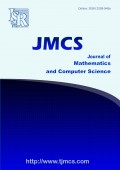An Improved Model of Brain Emotional Learning Algorithm Based on Interval Knowledge
-
3261
Downloads
-
5966
Views
Authors
Yousef Sharafi
- Computer Department of Islamic Azad University Science and Research Branch, Tehran, Iran
Saeed Setayeshi
- Faculty of Nuclear Engineering and Physics, Amirkabir University, Tehran, Iran
Alireza Falahiazar
- Computer Department of Islamic Azad University Science and Research Branch, Tehran, Iran
Abstract
The brain emotional learning algorithm inspired by a reduced system of a computational model simulates the brain learning performance quite simply with mimicking mammalian brains. The present paper endeavors to come forward to an improved model of the emotional learning algorithm based on the interval knowledge. In this proposed model, based on the interval knowledge, the weights of the amygdala and orbitofrontal sections will be updated. Eventually, the results of implementing and performing the improved brain emotional learning algorithm will be presented to be compared with the original version of the algorithm to Prediction the chaotic time series, Lorenz and Rossler, about which a noticeable improvement in its precision, accuracy and speed of convergence of the final results is reported.
Share and Cite
ISRP Style
Yousef Sharafi, Saeed Setayeshi, Alireza Falahiazar, An Improved Model of Brain Emotional Learning Algorithm Based on Interval Knowledge, Journal of Mathematics and Computer Science, 14 (2015), no. 1, 42-53
AMA Style
Sharafi Yousef, Setayeshi Saeed, Falahiazar Alireza, An Improved Model of Brain Emotional Learning Algorithm Based on Interval Knowledge. J Math Comput SCI-JM. (2015); 14(1):42-53
Chicago/Turabian Style
Sharafi, Yousef, Setayeshi, Saeed, Falahiazar, Alireza. "An Improved Model of Brain Emotional Learning Algorithm Based on Interval Knowledge." Journal of Mathematics and Computer Science, 14, no. 1 (2015): 42-53
Keywords
- Brain Emotional Learning Algorithm
- Interval Knowledge
- Chaotic Time Series
- Prediction
MSC
References
-
[1]
A. Ghezelbash, Predicting Changes in Stock Index and Gold Prices to Neural Network Approach, The Journal of Mathematics and Computer Science, 4 (2012), 227-236.
-
[2]
M. Bagheri, M. Valipour, V. Amin, The Bankruptcy Prediction in Tehran shareholding using Neural Network and it ’s Comparison with Logistic Regression, The Journal of Mathematics and Computer Science, 5 (2012), 219-228.
-
[3]
M. M. Javidi, M. H. Nattaj, A New and Quick Method to Detect DoS Attacks by Neural Networks, The Journal of mathematics and computer Science, 6 (2013), 85-96.
-
[4]
Z. Falahiazar, M. Rohani, A. Falahiazar, Controlling the False Alarm in an Intrusion Tolerant Database System Using Significance Degrees of Data Objects, Journal of mathematics and computer science, 13 (2014), 212-225.
-
[5]
Martin T. Hagan, Mohammad B. Menhaj, Training feed forward networks with the Marquardt algorithm, Neural Networks, IEEE Transactions on 5, 6 (1994), 989-993.
-
[6]
L. Falahiazar, M. Teshnehlab, A. Falahiazar, Parallel Genetic Algorithm Based on a New, in International Conference on Recent Advances in Computing and Software Systems, (2012)
-
[7]
Y. Sharafi, M. Ahmadieh Khanesar Teshnehlab, Discrete Binary Cat Swarm Optimization Algorithm, in Computer, Control & Communication (IC4), 3rd International Conference on, (2013)
-
[8]
J. M. Jenkins, K. Oatley, N. L. Stein, Human emotions: a reader, Blockwell, (1998)
-
[9]
E. T. Rolls, Neurophysiology and Functions of the Primate Amygdala. In: The Amygdala: Neurobiologycal Aspects of Emotion, Memory and Mental Dysfunction, (1992)
-
[10]
J. Le Doux, The Emotional Brain , Simon and Schuster, New York (1996)
-
[11]
J. L. McGaugh, F. Bermudez-Rattoni, R. A. Prado-Alcala, Plasticity in the Central Nervous System: Learning and Memory, Lawrence Erlbaum Associates, Inc., Mahwah, NJ., (1995), 17-39.
-
[12]
J. Morén, C. Balkenius, A Computational Model of Emotional Learning in the Amygdala, In: From Animals to Animats 6, Proceedings of the 6th International Conference on the Simulation of Adaptive Behaviour, Meyer, J.A., A. Berthoz, D. Floreano, H.L. Roitblat and S.W. Wilson (Eds.). MIT Press, Cambridge, MA. USA. , (2000), 115-124.
-
[13]
P. Lingras, Rough Neural Networks, in: Proceedings of the Sixth International Conference on Information Processing and Management of Uncertainty, Granada, (1996), 1445–1450.
-
[14]
S. Chandanal, V. Mayorga, The New Rough Neuron, Neural Networks and Brain, Beijing, (2005), 13-18.
-
[15]
C. Balkenius, J. Morén, Emotional Learning: A Computational Model of Amygdala, Cybernetics and Systems, 32 (2001), 611-636.
-
[16]
C. Lucas, D. Shahmirzadi, N. Sheikholeslami, Introducing BELBIC: Brain emotional learning based intelligent controller, Int. J. Intell. Autom. Soft Comput. , 10 (2004), 11-21.
-
[17]
E. Lotfi, M. R. Akbarzadeh, Supervised Brain Emotional Learning, Int. J. Intell. Autom. WCCI 2012 IEEE World Congress on Computational Intelligence, June, Brisbane, Australia, (2012), 10-15.

